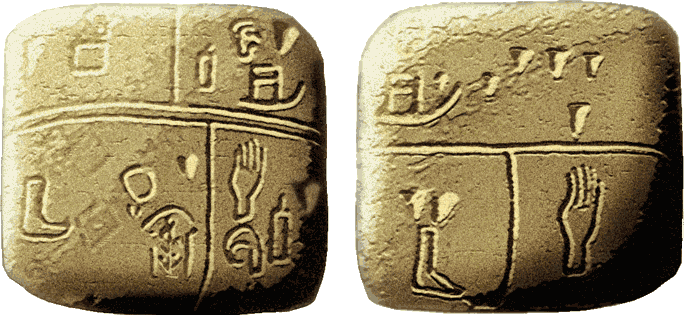
Image by José-Manuel Benito, via Wikimedia Commons
Some refer to the written Chinese language as ideographic: that is, structured according to a system in which each symbol represents a particular idea or concept, whether abstract or concrete. That’s true of certain Chinese characters, but only a small minority. Most of them are actually logographs, each of which represents a word or part of a word. But if you dig deep enough into their history — and the history of other Asian languages that use Chinese-derived vocabulary — you’ll find that some started out long ago as pictographs, designed visually to represent the thing to which they referred.
That doesn’t hold true for Chinese alone: it appears, in fact, that all written languages began as forms of pictographic “proto-writing,” at least judging by the earliest texts currently known to man. If we look at the oldest of them all, the limestone “Kish tablet” unearthed from the site of the eponymous ancient Sumerian city in modern-day Iraq, we can in some sense “read” several of the symbols in its text, even five and a half millennia after it was written. “The writing on its surface is purely pictographic,” says the narrator of the brief IFLScience video below, “and represents a midpoint between proto-writing and the more sophisticated writing of the cuneiform.”
Cuneiform, previously featured here on Open Culture, was used by the ancient Babylonians to label maps and record stew recipes, among other important tasks. “First developed around 3200 B.C. by Sumerian scribes in the ancient city-state of Uruk, in present-day Iraq, as a means of recording transactions, cuneiform writing was created by using a reed stylus to make wedge-shaped indentations in clay tablets,” says Archaeology magazine. Over 3,000 years, this earliest proper script “was used by scribes of multiple cultures over that time to write a number of languages other than Sumerian, most notably Akkadian, a Semitic language that was the lingua franca of the Assyrian and Babylonian Empires.”
Cuneiform was also used to write the Scheil dynastic tablet, which dates from the early second millennium BC. That means we can read it, and thus know that it comprises a literary-historical text that lists off the reigns of various rulers of Sumerian cities. We should note that the Scheil dynastic tablet is also, sometimes, referred to as the “Kish tablet,” which surely causes some confusion. But for the anonymous writer of the earlier Kish tablet, who would have lived about two millennia earlier, the emergence of cuneiform and all the civilizational developments it would make possible lay far in the future. His pictographic text may never be deciphered properly or mapped to a historically documented language, but at least we can tell that he must surely have had hands and feet more or less like our own.
Related content:
How Writing Has Spread Across the World, from 3000 BC to This Year: An Animated Map
40,000-Year-Old Symbols Found in Caves Worldwide May Be the Earliest Written Language
Based in Seoul, Colin Marshall writes and broadcasts on cities, language, and culture. His projects include the Substack newsletter Books on Cities and the book The Stateless City: a Walk through 21st-Century Los Angeles. Follow him on Twitter at @colinmarshall or on Facebook.


“The driver has picked up your dinner order, but has to make one other stop first.”
A whole lot of nothing. Did they give any interpretation of the “text” in English or any modern language? No, that should be no concern for the hoi polloi. This is Junior World Book stuff for mass consumption. The Narmer Palette in Egypt 3125 BC is undoubtedly older than any cuneiform in Mesopotamia which “experts” have stretched back artificially to way before the actual historical record in Mesopotamia, just to wrongly give Mesopotamia a precedence over Egypt and Nile valley.
Your assertion that the Narmer Palette script is older than cuneiform and that the latter has been falsely attributed as such is incorrect and unsupported by existing archaeological data. The development of cuneiform in Mesopotamia can be traced back to three dimensional abstract models of animals and other commodities contained within sealed clay bullae, and even older clay counters and tally sticks used to represent quantities that were already in widespread use across the Fertile Crescent, all of which are well represented in the archaeological record. We also know that indirect cultural exchange took place between Late Uruk/Jemdet Nasr period Sumer and Predynastic/Early Dynastic Egypt that for a short time heavily influenced the latter, including the Narmer Palette itself as well as other high-prestige artifacts such as the Gebel-el-Arak knife that bears a Sumerian king and early Pharaonic mastabas styled after Sumerian platform temples. It is possible that even the concept of writing itself was passed to Egypt through such indirect contact, as there are only a few previous stages we can find regarding the sudden appearance of well developed Egyptian Hieroglyphic shortly after writing appears in Sumer.